Have you ever wondered about the science behind the rejuvenating feeling you get after stepping out of a cold shower or an ice bath? There’s a reason athletes are seen plunging themselves into baths filled with ice after a grueling session. This process, known as cold therapy, not only serves as a refreshing jolt to your system but offers various potential benefits, particularly regarding energy metabolism. Together, we’ll explore how cold therapy might alter your body’s energy metabolism, breaking down its effects and benefits.
Understanding Cold Therapy
Cold therapy, often referred to as cryotherapy, involves the application of cold to the body tissues after an injury or physical activity. It’s a common practice for reducing inflammation, pain, and muscle spasms. However, its applications have extended beyond just sports and physical therapy, reaching into the realms of weight loss and energy metabolism. The body’s response to cold has intrigued scientists and biohackers alike, seeking to harness its potential physiological benefits.
Different Modes of Cold Therapy
From taking chilly showers to using advanced cryotherapy chambers, there are multiple ways to incorporate cold therapy. Here’s a closer look:
-
Cold Showers and Baths: A method accessible to many is taking cold showers or immersing yourself in a cold bath. It’s relatively easy, requiring only a source of cold water.
-
Ice Packs: Often used for targeted applications, ice packs can be applied to specific body areas to reduce pain and inflammation.
-
Cryotherapy Chambers: The latest in cold therapy involves spending a few minutes in a chamber at extremely low temperatures, sometimes even below -100°C.
-
Whole-body Cryotherapy: This advanced form involves brief exposure to extremely cold air, aiming to stimulate physiological responses throughout the body.
Each variation aims to achieve similar outcomes, though the intensity and impact can vary based on the method employed.
Energy Metabolism: The Basics
To understand how cold therapy influences energy metabolism, let’s first navigate its fundamentals. Energy metabolism involves all biochemical processes transforming food and drink into energy. These processes are vital as this energy is used for everything – from cellular function, muscular activity, to maintaining body temperature.
Key Players in Energy Metabolism
Energy metabolism is controlled by numerous hormones and enzymes working cohesively. Here are some of the primary processes and components:
-
Metabolic Rate: It’s the rate at which your body utilizes energy. Cold therapy can influence this by potentially increasing it, leading to enhanced calorie burn.
-
Brown Adipose Tissue (BAT): Unlike its counterpart white fat, BAT is metabolically active. Cold temperatures can stimulate BAT, leading to increased energy expenditure.
-
Mitochondria: Often labeled the powerhouse of cells, mitochondria play a pivotal role in energy production. Enhancing their efficiency can optimize energy metabolism.
The Science Behind Cold-Induced Thermogenesis
Thermogenesis refers to the process of heat production in organisms. Cold exposure has been shown to activate thermogenesis, effectively increasing energy expenditure. The body has to work harder to maintain its core temperature when exposed to cold, leading to a rise in calorie consumption.
Brown Fat Activation
One of the fascinating aspects of thermogenic response is the activation of brown fat. Unlike white fat, which stores energy, brown fat actively burns calories to generate heat. Studies indicate that short periods of cold exposure can increase brown fat activity, thus enhancing calorie expenditure.
| Aspect | Brown Fat Function | White Fat Function |
|---|---|---|
| Calorie Use | Burns calories for heat production | Stores excess calories for energy reserves |
| Response to Cold | Activates to generate heat and maintain body warmth | Largely inactive in heat production, primarily stores energy |
| Cellular Components | Rich in mitochondria, contributing to its brown color | Fewer mitochondria, leading to minimal heat production |
Modulating Hormones and Enzymes
Cold exposure’s influence extends to various hormones and enzymes affecting energy metabolism.
Key Hormonal Changes
-
Norepinephrine: As a critical player in the sympathetic nervous system, norepinephrine rises during cold exposure. It plays a role in mobilizing energy stores and activating brown fat cells.
-
Insulin Sensitivity: Some studies suggest that regular cold exposure could enhance insulin sensitivity, possibly aiding in better glucose management.
Enzyme Activation
Cold therapy may stimulate enzymes involved in lipid and carbohydrate metabolism. While more research is needed, early studies show promise in understanding these enzymes’ increased functionality under cold conditions.
Potential Benefits of Cold Therapy on Metabolism
Embracing cold therapy could offer several potential metabolic benefits. Although ongoing research seeks to provide more definitive answers, here are some advantages currently under exploration:
Caloric Expenditure and Weight Regulation
One of the standout effects of cold therapy is its potential role in facilitating weight management. Since cold exposure can stimulate an increase in metabolic rate and brown fat activity, it may lead to more calories burned even at rest.
Enhanced Athletic Recovery
When it comes to sports and exercise, cold therapy is a revered ally. By helping reduce muscle soreness and inflammation, it can enhance recovery, aiding athletes in maintaining consistent performance levels.
Improved Mood and Mental Clarity
Beyond the physical, there are psychological benefits attributed to cold exposure. Anecdotal evidence and emerging studies suggest potential improvements in mood and cognitive function, likely due to increased circulation and endorphin release after exposure.
Risks and Considerations
Despite its benefits, cold therapy is not without its risks. It’s crucial to consider these before diving into any cold-related practices.
Risks Involved
-
Hypothermia: Extended cold exposure can lead to this dangerous drop in body temperature, posing serious health risks.
-
Frostbite: Particularly in cryotherapy chambers or with extremely cold packs, frostbite can occur if the skin is exposed for too long.
Safety Guidelines
Adhering to safety measures is essential in reaping cold therapy’s benefits without adverse consequences. Here are a few recommendations:
- Gradually acclimate your body to cold exposure.
- Limit initial sessions to shorter durations.
- Keep warm clothing available to use immediately after the session.
- Always consult with a healthcare provider before starting any new therapy, especially if you have underlying health conditions.

A Customized Cold Therapy Approach
Given the varied forms and potential benefits, it’s essential to tailor cold therapy to fit individual needs and tolerances.
Steps to Personalizing Your Approach
-
Assess Tolerance: Start with mild forms, such as cold showers, gradually increasing duration and intensity.
-
Determine Goals: Whether it is enhanced recovery, mood improvement, or metabolic support, identify what you hope to achieve.
-
Monitor Progress: Keep track of how your body responds. Adjust frequency and intensity accordingly to optimize benefits.
-
Seek Professional Guidance: Consider consulting with specialists familiar with cryotherapy or sports medicine to guide your regimen.
Summing Up: Cold Therapy’s Potential
The potential impacts of cold therapy on energy metabolism present exciting possibilities. Whether enhancing metabolic rates through brown fat activation or simply providing a mental boost, the benefits span both physical and mental aspects. Yet, like every therapeutic approach, there’s a need for informed application and awareness of potential risks. By combining personal experience with scientific insights, you can harness cold therapy as a tool to benefit your overall well-being. So, as you consider the chilling endeavors ahead, remember the possibilities that await on the cooler side of wellness.





